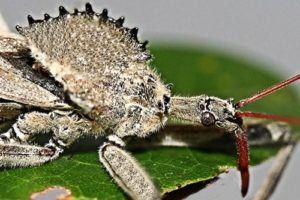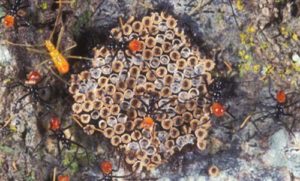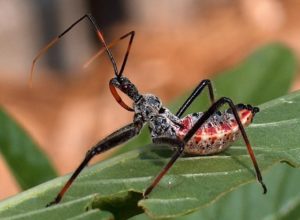Arilus cristatus

Commonly called the “Wheel bug”
Approximately 1 – 1.25 inches long
Life Cycle: Egg, Nymph, Adult



- Domain: Eukaryota
- Kingdom: Metazoa
- Phylum: Arthropoda
- Subphylum: Uniramia
- Class: Insecta
- Order: Hemiptera
- Suborder: Heteroptera
- Family: Reduviidae
- Genus: Arilus
- Species: Arilus cristatus
- (1)
A. cristatus is a diurnal organism (meaning active during the day) that is generally considered beneficial. This species has one generation per year, with its’ egg stage present during the winter, nymphs hatching soon after and adults typically found between May and June. A. cristatus is a predatory species, that is very helpful with pest control, A. cristatus can be found widely distributed across the eastern united states. (2)
Below in gray is the Distribution of this insect in the United States:

retrieved from (2)
According to F.W. Mead, (Florida Department of Agriculture and Consumer Services, Division of Plant Industry) and Donald W. Hall, (University of Florida) the bite of A. cristatus is more severe than that of a bee sting. Therefore these insects should be handled with caution ( both nymphs and adults). Particularly due to the fact that nypmhs and adults have been known to be fairly aggressive. (3)
Interestingly, these bugs produce chirping sounds, and when threatened release a foul smell originating from what are called Brindley’s glands on the thorax.
Many of you may be asking, WHY in the world is he writing about this bug?”
Well the answer is fairly simple. Because I myself was very interested in this bug. These insects seem to stand out to me partially due to their appearance. Sinister as they appear, these insects are like most arachnids in the fact that they are beneficial to humans in many ways. I like many scientist want to share my interest and I hope you found this insect interesting.
Thanks for reading,
Mr. Merritt
Please visit the following links if you would like to know more about A. cristatus
http://entnemdept.ufl.edu/creatures/trees/wheel_bug.htm
https://extension.umd.edu/hgic/topics/predators-assassin-bugs
https://hortsciences.tamu.edu/galveston/beneficials/beneficial-09_wheel_bug.htm
https://entomology.ca.uky.edu/ef426
https://www.cabi.org/isc/datasheet/6958
http://ninnescahlife.wichita.edu/node/684
References